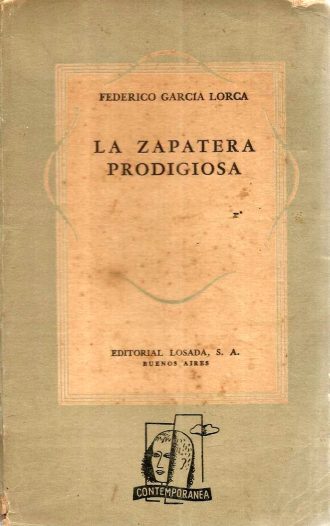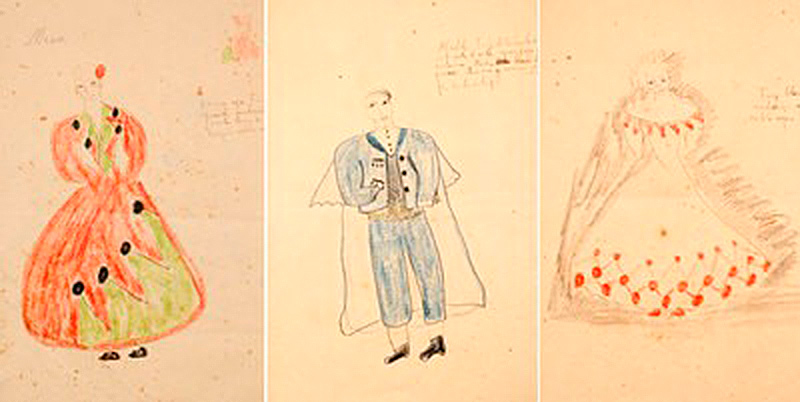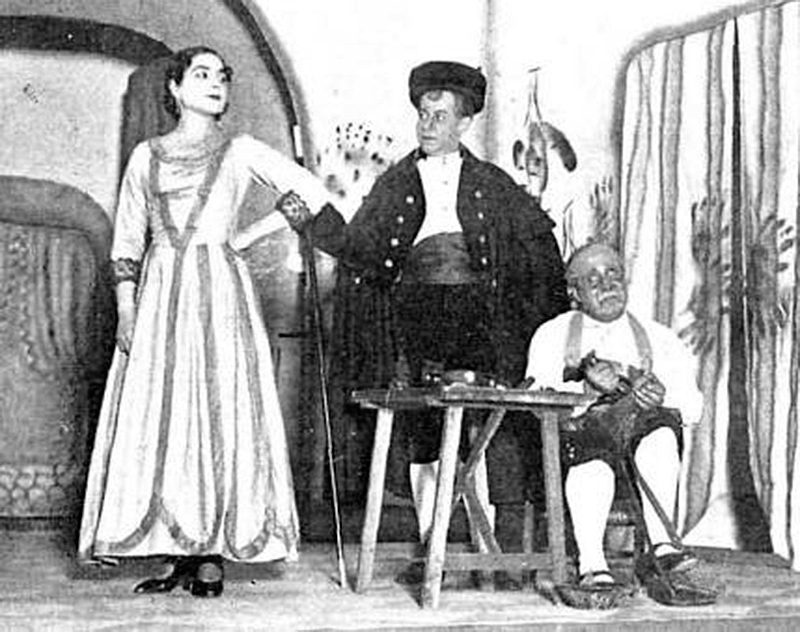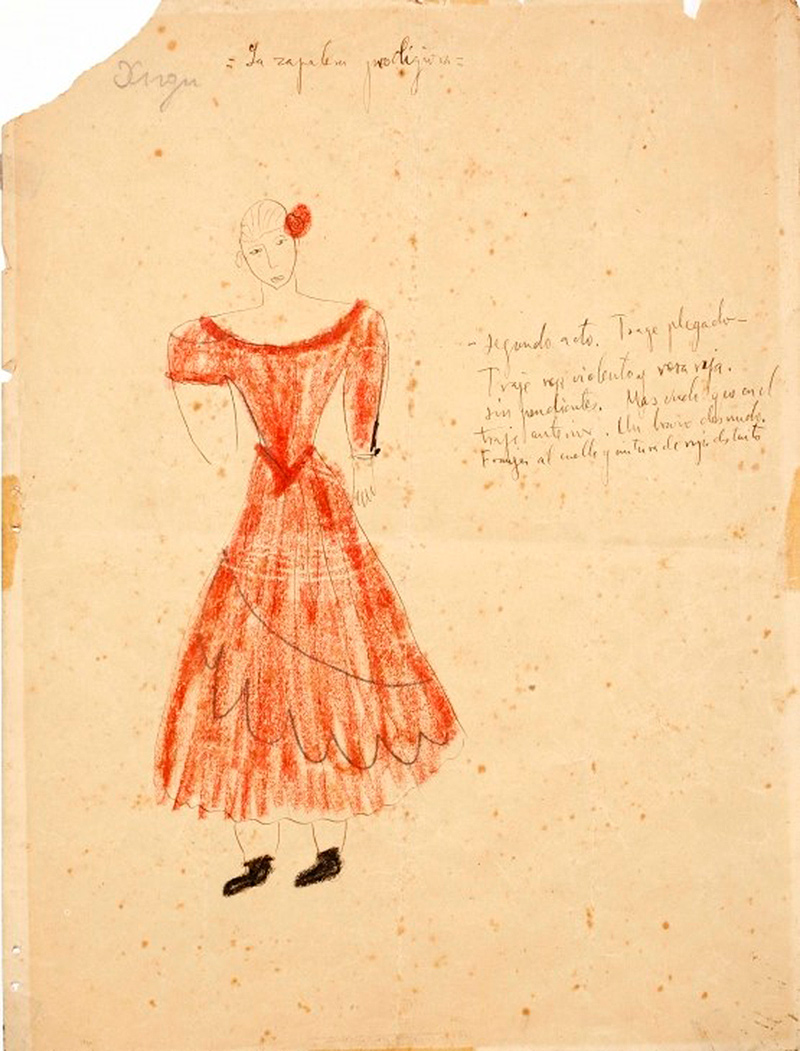
The farce for people, conceived almost as a ballet, of The Shoemaker’s Prodigious Wife: a violent farce in two acts (La zapatera prodigiosa) resorts to a theme that is not new in literature, that of a young woman married to an older man. The play is distributed in two acts preceded by a prolog by the author.
In the first act, the Shoemaker’s Wife appears in a constant argument with her husband, the Shoemaker. She regrets having married him, being so young and having such good looks. She shows a rebellious attitude with respect to what is expected of a married woman, reproaching the neighbors for their gossip, answering rudely to her husband and listening to all the men who came to flatter her. The only person she treats well is a child who visits her and brings her news of the gossip in the street. The Shoemaker, fed up with his wife’s attitude, decides to leave home.

In the second act, the Shoemakers’ Wife, now alone, has turned her house into a tavern and serves drinks to the same young men who wanted to conquer her from the beginning, including the Mayor. Her personality remains the same, but she is not willing to be conquered by anyone, as she has decided to remain faithful to her husband whom she has realized she loved and misses. Meanwhile, the townspeople continue to criticize her and even sing songs with her story. One day a puppeteer arrives in the village with his rolled-up poster carrying the “Alleluias of the meek shoemaker and the Fierabras of Alexandria” and other stories to tell the people. It is about the Shoemaker in disguise. In the conversation between the Shoemaker’s Wife and the puppeteer in the tavern, they confess the love they each feel for the husband and wife who has abandoned them. Meanwhile, the Shoemaker’s Wife’s suitors fight in the street and the whole town blames her. Finally, the Shoemaker reveals his true identity and the play ends with the two of them happy to be together again and ready to defend themselves from the people.

On December 24, 1930 (with the anger of Federico’s parents for not being at home on Christmas Eve) it premiered at the Teatro Español in Madrid directed by Cipriano Rivas Cherif. The performers of this premiere were: Margarita Xirgu (Shoemaker), Alejandro Maximino (Shoemaker), Matilde Fernández (Boy), José Cañizares (Adult), Femando Porredón (Mr. Mirlo), Fernando Venegas (waiter), Julia Pachelo, Mimí Muñoz and Pascuala Mesa (Neighbors).
Lorca himself reads the prolog of the play, dressed in a star-covered cape. The scenography is by Salvador Bartolozzi (based on Lorca’s own drawings). He manages to put on about thirty performances and strengthens his relationship with Margarita Xirgu.
On April 5, 1933, it will be performed at the Cultural Theater Club (Anfístora) to which Federico had been associated and which was directed by Pura Maortua de Ucelay. On December 1, 1933, in Buenos Aires, at the Teatro Avenida, with Lola Membrives as Shoemaker. The sets were to be designed by Manuel Fontanals. This is a more complete version than the one staged by Margarita Xirgu, with which Lorca was to be happier, as it incorporates the music and songs that he personally supervised, as well as some extended dialogue. The play was to be a success in Buenos Aires.
La zapatera prodigiosa (The Shoemaker’s Prodigious Wife) draws on many elements from Federico’s childhood in the Vega of Granada: the green costume worn by the protagonist – the same color as the one worn by Adela in La casa de Bernarda Alba (The House of Bernarda Alba) – is an imitation of one worn by Clotilde García Picossi, Federico’s cousin, and which she could not premiere because of a time of mourning; the “polquita antigua” (old polka) from La zapatera (The Shoemaker’s Wife). played in the street by a flute and a guitar is, according to Lorca, the one played by Pepe El Pintor with a clarinet; the Mayor is the one who held that office in Chauchina when he was a child, nicknamed el Pongao; the Child could pick up autobiographical elements, such as the enthusiasm before the arrival of the puppets to the town; the language of the Shoemaker’s Wife apparently comes from the maid of Emilia Llanos, Dolores Cebrián; the personalities of the village people, the gossip, the custom of going to recite the rosary, or going to the casino, the arrival of the flocks in the afternoon with their shepherd, the limitations for a woman in a village (“As far as I see, in this village there are only two extremes: either nun or cleaner”), draws on everything Lorca experienced in his peasant childhood, first in Fuente Vaqueros and, later, in Asquerosa (Disgusting).
In the interviews Lorca gives to the press the following day, he complains, once again that La zapatera prodigiosa (The Shoemaker’s Prodigious Wife), written several years earlier, no longer represents his vision of theater.

Finished in 1924, he shows it in November of that year to Martínez Sierra and is convinced that he will premiere it, since Catalina Bárcena will have a great role in La Zapatera (The Shoemaker’s Wife) . In March 1925, Martínez Sierra is still committed to premiering the play, but in the provinces, to see the reaction of the public. Federico is going to try to do it in Madrid. Meanwhile the problem of Primo de Rivera’s censorship also arose with Mariana Pineda. It would not premiere until December 24, 1930, at the Teatro Español (Spanish Theater) in Madrid, directed by Cipriano Rivas Cherif and starring Margarita Xirgu.
Francisco García Lorca, in analyzing the idiosyncrasy of the two towns where his brother Federico spent his childhood, dares to make the following judgment: “Without giving too rigorous an interpretation to what I am going to say, La zapatera prodigiosa (The Shoemaker’s Prodigious Wife) could be the literary projection of the character of Fuente Vaqueros and La casa de Bernarda Alba (The House of Bernarda Alba), in Valderrubio”.
The shoemaker’s prodigious wife, TVE, 1995. Directors: Pedro Amalio López, Luis Olmos